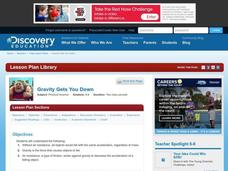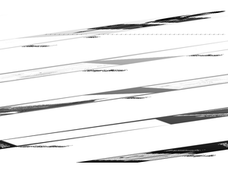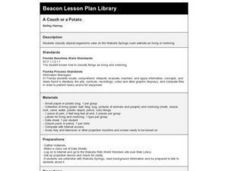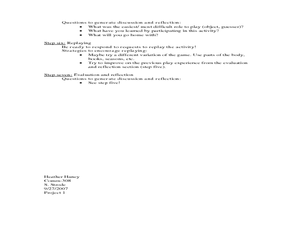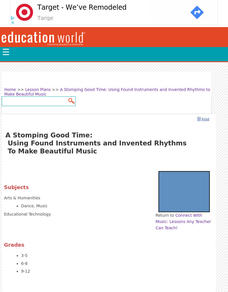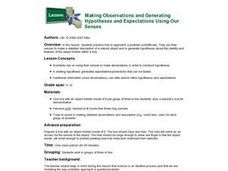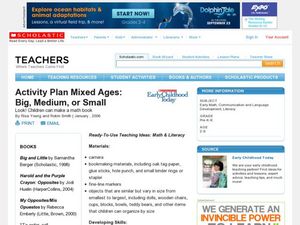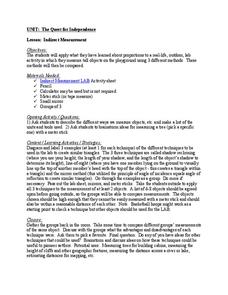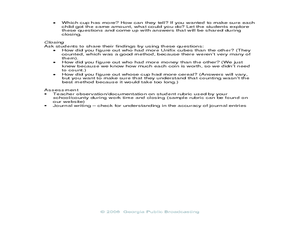Curated OER
Classifying
In this classifying worksheet, students are given 8 rows of illustrations of animals. Students try out various ways to organize the animals in a classification system following the directions. They try a 2 groups system and a 3-5 group...
Curated OER
Gravity Gets You Down
Middle schoolers design an experiment to investigate how objects with different masses fall. In this physics instructional activity, students predict how these objects will fall in a vacuum tube. They write a report explaining...
Curated OER
Make a Nature Mobile
Young scholars take nature walks to collect items from the environment such as leaves, shells, branches, feathers, and seeds. Working in groups, they assemble their items into mobiles and display them in the classroom.
Curated OER
Ceramics: A Vessel Into History
Students examine ceramic vessels from different time periods. In this ceramic vessel instructional activity, students work in small groups to look at images of ceramic vessels from a number of time periods. They identify the...
Curated OER
Density And Volume
Sixth graders explore the concept of density as a relationship of an object's mass to its volume. Densities of a variety of objects are compared and used to identify an unknown object.
Curated OER
Big Enough?
Students explore the concept of density and buoyancy. In this physics lesson, students discover the different factors that affect an object's density and buoyancy in water. Students conduct several investigations to further...
Curated OER
A Couch or a Potato
Students classify objects and organisms seen on the Wakulla Springs icam website as living or nonliving.
Curated OER
"No, You Can't Take Me!"
Students study imitation or pantomime. In this creative drama lesson, students pick an object to imitate and state the reasons why that object should not be taken out of the room pretending to be that object.
Curated OER
Is a Pulley a Special Kind of Lever?
Fifth graders use information from their text to read and discuss pulleys and levers. They examine a top sketch of the arrangement of a fixed pulley. Working in groups, 5th graders perform experiments to test the effect of using a pulley...
Curated OER
Why Do Certain Things Float, While Some Sink?
First graders conduct an experiment. In this density activity, 1st graders work in groups to test 10 different objects to see which ones sink and float. Students discuss why certain objects float and others do not.
Curated OER
Six of One, Half Dozen of the Other
Learners explore the garden with all five senses. In this Science lesson, students collect specimens from the garden to classify. Learners use adjectives to describe the objects collected.
Curated OER
UFOs
Students, in groups, construct a catapult. Then they conduct a series of experiments by catapulting a marshmallow, using different lengths of spoons, across the room. They predict, measure, and record the measured distance on a worksheet.
Curated OER
Insulators and Conductors
Students conduct an experiment in which they create open and closed circuits. In this insulators and conductors lesson, students review open and closed circuits and then get in groups to make both kinds of circuit. ...
Curated OER
A Stomping Good Time: Using Found Instruments and Invented Rhythms to Make Beautiful Music
Students work in small groups to use everyday objects to create performances inspired by the work of STOMP. They create a system of notation to document the music and movement of a 2-minute performance.
Curated OER
Mapping and Excavating a Jello Mold
Students simulate how archaeologists excavate sites by "searching" their own site in the form of a Jello mold. They use a grid to map the objects in the Jello mold as well as looking at three layers of Jello to understand stratigraphy...
Curated OER
Density - An Introduction
Students experiment with objects of different densities. In this density lesson, students examine same-sized objects with different weights, then look at a teacher explanation of density. Students make wave bottles and a density jar to...
Curated OER
Making Observations and Generating Hypotheses
Students practice how to approach a problem scientifically. They use their senses to make a detailed description of a natural object and to generate hypotheses about the identity and features of the object hidden within a box.
Curated OER
Activity Plan Mixed Ages: Big, Medium, or Small
Students make a math book. In this early childhood math lesson plan, students develop language, observation, and math skills as they explore the sizes of objects and use cameras to take pictures for their own math booklet based on...
Curated OER
Indirect Measurement
Young scholars measure and apply their knowledge of proportion to solve problems. In this geometry lesson, students measure using a meter stick, small mirror and measuring tape. They compare and contrast their measurements to objects...
Alabama Learning Exchange
Light Reflection and Absorption
Students discover what types of objects reflect and absorb light. In this science inquiry activity, students use flashlights to determine whether different objects absorb or reflect light.
Curated OER
Forces and Motion Scavenger Hunt
Students determine how force on an object affects its movement. For this force and motion lesson, students take digital pictures of objects in the school setting that are pushed and pulled. They develop a presentation using the digital...
Curated OER
More! A Lesson on Comparing
Students practice counting and comparing objects. In this math lesson, students view a Count on It! episode. Students examine the value of what they are counting. Students estimate number in groups of items. Students...
Curated OER
Measurement
Learners investigate non-standard linear measurement. In this cross curriculum measurement lesson, students listen to the book Measuring Penny by Loreen Leedy, and identify pages in which non-standard measurement is used. ...
Curated OER
Polydron Fun
Students investigate nets as they relate to volume and area. In this geometry instructional activity, students use nets as a visual to deepen their understanding of surface area and volume of objects. They make conjectures about...



